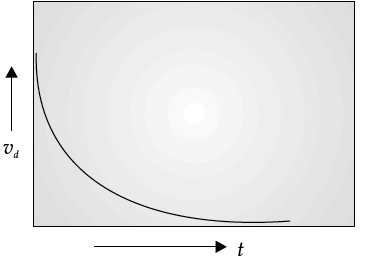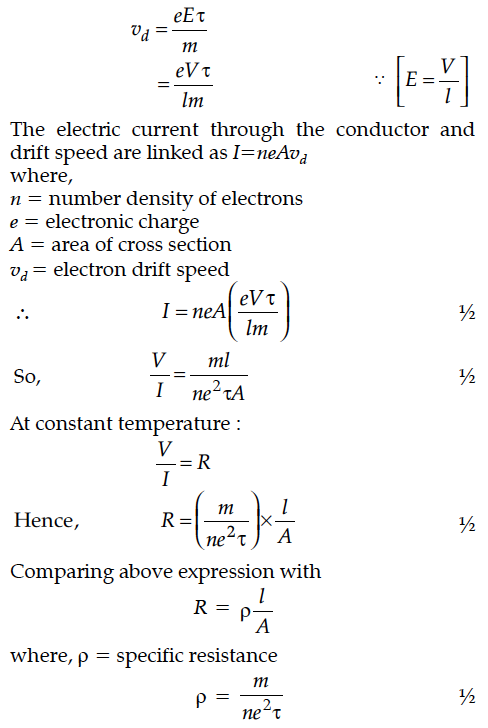What is relaxation time ? Derive an expression for resistivity of a wire in terms of number density of free electrons and relaxation time.
(i) Relaxation time shows the effect of collisions among the electrons and ions or impurities on electrical conduction in a metal. It is the time taken for the drift velocity to decay 1/e of its initial value.
As drift velocity increases, relaxation time decreases since the electrons move the distance in which they frequently collide faster.

(ii) When a potential difference V is applied across conductor of length l, then drift speed of electron will result as :

As drift velocity increases, relaxation time decreases since the electrons move the distance in which they frequently collide faster.

(ii) When a potential difference V is applied across conductor of length l, then drift speed of electron will result as :

How does one explain increase in resistivity of a metal with increase in temperature ?
Draw a graph to show the variation of resistance of a metal wire as a function of its diameter keeping its length and material constant.
Calculate the current drawn from the battery by the network of resistors shown in the figure.
Give an example of a material each for which temperature coefficient of resistivity is:
(i) positive, (ii) negative.
Plot a graph showing the variation of current I versus resistance R, connected to a cell of emf E and internal resistance r.
Define an equipotential surface. Draw equipotential surfaces :
(i) in the case of a single point charge and
(ii) in a constant electric field in z-direction. Why the equipotential surfaces about a single charge are not equidistant ?
(iii) Can electric field exist tangential to an equipotential surface ? Give reason.
Define relaxation time of the free electrons drifting in a conductor. How is it related to the drift velocity of free electrons ? Use this relation to deduce the expression for the electrical resistivity of the material.
Two material bars A and B of equal area of crosssection, are connected in series to a DC supply. A is made of usual resistance wire and B of an n-type semiconductor.
(i) In which bar is drift speed of free electrons greater?
(ii) If the same constant current continues to flow for a long time, how will the voltage drop across A and B be affected?
Justify each error.
A student connects a cell, of emf E2 and internal resistance r2 with a cell of emf E1 and internal resistance r1, such that their combination has a net internal resistance less than r1. This combination is then connected across a resistance R. Draw a diagram of the 'set-up' and obtain an expression for the current flowing through the resistance.
(i) Derive the expression for the electric potential due to an electric dipole at a point on its axial line.
(ii) Depict the equipotential surface due to electric dipole.
A charge is distributed uniformly over a ring of radius ‘a’. Obtain an expression for the electric intensity E at a point on the axis of the ring. Hence, show that for points at large distances from the ring, it behaves like a point charge.
Derive an expression for electric field of a dipole at a point on the equatorial plane of the dipole. How does the field vary at large distances?
